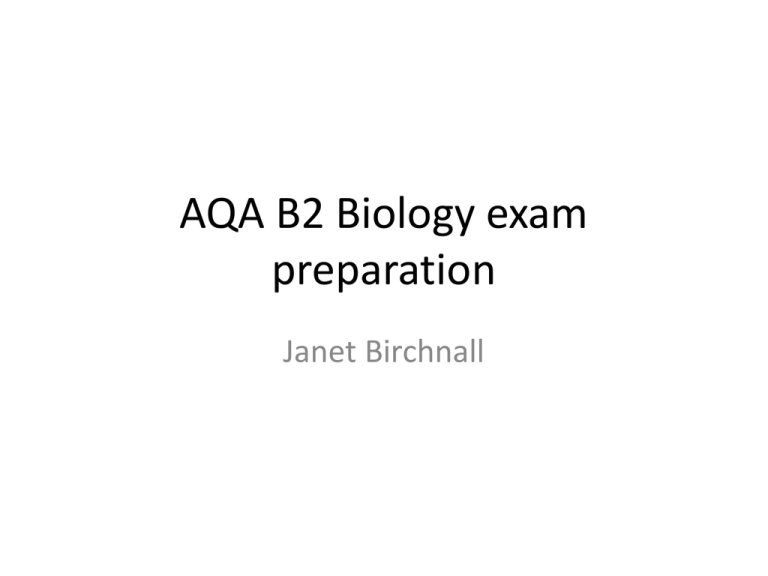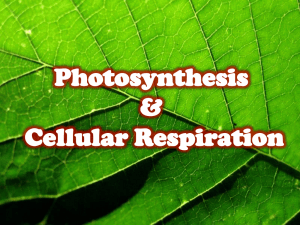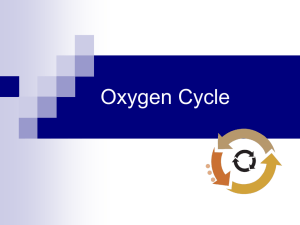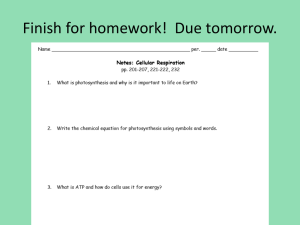
AQA B2 Biology exam
preparation
Janet Birchnall
In the next 10 mins….
• What kind of things will be in the exam?
• Examples of questions your child will face
• Styles of questioning: knowledge, application,
evaluation
• Revision pack - instructions of where to find
resources, plus a starter pack for you to take
away
Label the cell:
Cell
membrane
Name four types of organism whose cells
have a cell wall and explain the function of
this.
Plant, algae, bacteria, fungi
Strengthens cell
Ribosomes
Nucleus
Mitochondrion
Label the cell:
Cell
membrane
Nucleus
Cell wall
Ribosomes
Vacuole
Cytoplasm
Chloroplast
Cytoplasm
What type of cell is it? Animal
Give 3 special features of a sperm cell and
explain how it helps the sperm function.
•Lots of mitochondria – release energy so can
swim to egg cell
•Long tail – to swim to egg
•Acrosome containing enzymes – digest egg
membrane.
What is the function of root hair cells and how
are they adapted?
To absorb water and nutrients.
Large surface area – speeds up absorption
Identify the cells below.
Bacterium
Mitochondrion
Give the functions of the following:
•Nucleus contains DNA: controls activities of
cell
•Cytoplasm cellular reactions take place here
•Mitochondrion releases energy during
aerobic respiration
•Cell membrane controls passage of
substances in and out of cell
•Ribosomes. Site of protein synthesis
What type of cell is it? Plant
Give 3 things that can speed up the rate of
diffusion.
Bigger diffusion gradient
Larger surface area
Shorter diffusion distance
What is diffusion?
The net movement of particles of a liquid or solute
from an area of high concentration to an area of lower
concentration
Yeast cell
What is unusual about the genetic
material in a bacterial cell?
Not inside a nucleus
Which organelle would you expect muscle cells o
have lots of and why?
Mitochondria
Need energy for contraction
What key process takes place in chloroplasts? Write
an equation.
Photosynthesis
Water + carbon dioxide -> glucose + oxygen
Beta cells in the pancreas
make lots of insulin,
which is a protein. What
organelle would you
expect to see in high
numbers?
Ribosomes
The diagram shows a human sperm. Inside the tail of the sperm is a filament mechanism that causes
the side to side movement of the tail, which moves the sperm.
6.
(a)
Describe the function of the mitochondria and suggest a reason why they are arranged around the
filament near the tail of the sperm.
.....................................................................................................................................
.....................................................................................................................................
.....................................................................................................................................
.....................................................................................................................................
(3)
(b)
Explain the significance of the nucleus in determining the characteristics of the offspring.
.....................................................................................................................................
.....................................................................................................................................
.....................................................................................................................................
(2)
(Total 5 marks)
What is an organ?
A part of an animal or plan made up of several
tissues working together to do a specific job.
Give a definition of a tissue.
A group of cells with similar structure and
function that work together to perform a
particular job
Add labels to the diagram of the digestive system and give
the function of each labeled part.
What are the key features of tissues or organs
designed to act as exchange surfaces?
Large surface area
Thin walls
Permeable surface
Good blood supply
Give the name and functions of the tissues in the leaf.
Palisade mesophyll
layer: carries out
photosynthesis
Epidermis:
protects
plant
Xylem and phloem:
transport water and
sugars
Muscle tissue:
churns contents.
Salivary glands:
produce digestive
enzymes (amylase)
Add labels to the diagram to
give the names of the plant
organs.
Leaf
Root
Epithelial tissue:
covers inside and
outside of stomach
http://www.kathimitchell.com/paclass.htm
http://www.turbosquid.com/FullPreview/Index.cfm/ID/547654
Stomach: site of
digestion
Pancreas: produce
digestive enzymes
(amylase, protease,
lipase)
Small intestine:
digestion and
absorption of
soluble products
Large intestine:
water absorbed
and faeces form
http://www.buzzle.com/articles/digestive-system-for-kids.html
What is the job of muscle
tissue?
Contracts to bring about
movement.
What does it mean if a cell is
differentiated?
It is specialized for a particular job.
Glandular tissue: produces digestive juices.
Liver: produces
bile
Flower
Stem
Label the diagram to give the names of the tissues that
make up the stomach and give the function of each.
What is the name given to a group of organs
working together to perform a particular
function?
Organ system
Name 2 substances produced by glandular tissue, and
2 organs in which you might find it.
Enzymes, Hormones
Stomach /Pancreas / Small intestine
Where will you find epithelial tissue? What are some of
its functions?
Lining body surfaces – protection or exchange
Write a word equation for photosynthesis.
Carbon + Water
Dioxide
Light
Glucose + Oxygen
Name the two reactants in
photosynthesis and state where
each comes from.
Carbon dioxide – air
Water - soil
State three things that can limit the rate
of photosynthesis.
■ shortage of light
■ low temperature
■ shortage of carbon dioxide.
Look at the graph below.
Describe and explain the effect of increasing light
intensity at 0.03% CO2.
What is meant by a limiting factor?
An environmental condition that when in
short supply slows down the rate of
photosynthesis.
What is the function of
cellulose?
It strengthens the cell wall.
Rate of photosynthesis increases up to 5 a.u.
Until 5 a.u. light is a limiting factor for
photosynthesis
Above 5 a.u. carbon dioxide is a limiting factor
What must be added to glucose
to make proteins and where
does this come from?
Nitrates from the soil
State four uses of glucose in
plants.
•Respiration
•To produce fat or oil for
storage
•To produce cellulose
•To produce proteins
Why might a farmer put a paraffin heater in a
greenhouse?
To increase carbon dioxide concentration and
increase the rate of photosynthesis.
Where is chlorophyll found?
In chloroplasts in plants and algal cells,
What is the function of chlorophyll?
Absorbs light energy which is used to convert
carbon dioxide and water to glucose and oxygen.
Name the substance that glucose can be converted
to for storage and describe how you can test for the
presence of this substance.
Starch
Test with iodine: changes from brown to blue-black if
starch is present
Explain the results obtained in the experiment below.
px=683&vpy=185&dur=1337&hovh=114&hovw=320&tx=212&ty=58&sig=104307363615294991887&page=1&tbn
h=107&tbnw=300&start=0&ndsp=18&ved=1t:429,r:9,s:0,i:98&biw=1333&bih=645
There is no chlorophyll in the white bits of the leaf
Without chlorophyll photosynthesis cannot take place
So no glucose is made
So no starch is made
So the iodine does not turn blue-black
1.
The graph shows how the rate of photosynthesis is affected by different conditions.
(a)
What patterns can you find from this graph?
.....................................................................................................................................
.....................................................................................................................................
.....................................................................................................................................
.....................................................................................................................................
.....................................................................................................................................
(5)
(b)
How useful could this information be to a grower using glasshouses? Give reasons for your answer.
.....................................................................................................................................
.....................................................................................................................................
.....................................................................................................................................
(2)
(Total 7 marks)
Explain what it means if your results are:
Reproducible: the same results are repeated by
someone else doing your experiment or by using a
different method
Repeatable: you repeat the experiment with the same
equipment and get the same results
Describe how you could use a quadrat to
investigate how the species of plants change
with distance from a river.
•Use a tape measure to create a line transect
•Place quadrats at regular intervals
•Count the number of species in each quadrat
Give two problems with using a count of nests to
estimate bird population.
Nests may be old / disused
Young birds may have not made their own nest yet
Describe how you would carry out random sampling to
compare the abundance of daisies in a 2 different fields
•Mark out an area in the first field using two tape
measures
•Used a random number generator to generate
coordinates
•Place the quadrat at each coordinate and count the
number of daisies in the quadrat
•Repeat several times in that field
•Calculate a mean number of daisies per quadrat
•Repeat all the steps above in the other field taking the
same number of samples
Quadrat number
Number of daisies
1
12
2
10
3
8
4
12
5
11
Describe how you could investigate how
leaf size changes with height on a bush.
•Use systematic sampling e.g. measure
every 5th leaf
•Draw round the leaf on graph paper
•Add together the number of squares
covered by the leaf, including half squares
Why is it important to have a large sample size?.
It allows you to identify anomalies.
Physical Factor
Why does it affect the distribution of living organisms?
Temperature
needs to be suitable for enzymatic reactions (different organisms
have different ideal temperatures)
Nutrient
availability
organisms need nutrients to synthesize new materials and grow
Light intensity
plants and algae need light for photosynthesis
Oxygen availability
needed by all organisms for respiration
Carbon dioxide
availability
needed by plants and algae for photosynthesis
Water availability
needed for photosynthesis or to keep animals hydrated (not often
a limiting factor though)
Look at the table of results on the left.
Calculate the
a. Mean 11
b. Median 11
c. Mode 12
If the mean number of clover plants per m2
quadrat is 6 and a field has a total area of 1200m2
how many clover plants would you expect to find
in the whole field.?
6 x 1200 = 7200
Give four functions of proteins in
living organisms
•Hormones
•Enzymes (catalysts)
•Antibodies
•Structural components of tissues
What is an enzyme and what is
its function?
Biological catalyst – speeds up
the rate of a reaction
Give two factors that affect
the rate of an enzyme
controlled reaction.
•Tempearture
•pH
Describe the structure of a protein.
Long chain of amino acids
Folded to produce a specific 3D structure
Add labels to the following
diagram of an enzyme-substrate
complex.
Active site
Enzyme
Why are biological washing powders
more ‘environmentally friendly’?
Allow you to wash clothes at a lower
temperature
Use less energy and therefore less fuel so
produce less pollution
What is meant by enzyme specificity and why are enzymes specific?
Each enzyme only catalyses one type of reaction.
Each enzyme has a different shape active site
What is the name of the enzyme used to
convert glucose to fructose?
Isomerase
Substrate
Which enzymes are contained in
washing powders?
Proteases
Lipases
Why is fructose used instead of glucose in
slimming foods?
Fructose is sweeter than glucose
So less is needed
What are carbohydrases used for in industry?
To cpnvert startch to sugar syrup
Give 2 disadvantages of using enzymes in industry.
Most enzymes are expensive to extract
Some people are allergic to certain enzymes
What type of organism do we use to produce enzymes
for industry and why?
Microorganisms
They reproduce rapidly so produce lots of enzyme
They are cheap and easy to handle
What is the name given to the
part of the enzyme that enables it
to recognize a substrate?
Active site
Explain what happens
when a enzyme
becomes denatured
Shape of the active
site changes so the
enzyme no longer
works,
Look at the graph on theleft which shows how temperature
affects an enzyme-controlled reaction.
a. Describe the effect of temperature on the rate of
reaction.
• Rate increases up to 400C
• Rate is at a maximum at 400C
• Above 400C rate rapidly falls
b) Explain the shape of the graph.
• Between 0 and 400C increasing tempearture increases
the kinetic energy of molecules so the enzyme and
substrate collide more often and with more force
• Above 400C the enzyme is denatured so can no longer
catalyse the reaction
What is the function of digestive enzymes?
To break large insoluble food molecules
into small soluble molecules that can be
absorbed.
Why is the average human body
temperature 370C?
Optimum temperature for most
enzymes
State where bile is
Produced? Liver
Stored? Gall bladder
Acts? Small intestine
What type of cells produce digestive enzymes?
Specialised cells in glands and the lining of the gut
Complete the table below to show where the
following enzymes are made and where they
act.
Enzyme
Where it is made
What type of enzyme is used in the
manufacture of baby foods and why?
Proteases to predigest the protein in the
food. .
Digestive enzymes are extracellular. What does
this mean?
They work outside of cells.
Where it acts
Amylase
Salivary glands,
pancreas, small
intestine
Mouth, small
intestine
Protease
Stomach, pancreas,
small intestine
Stomach,
small intestine
Lipase
Pancreas, small
intestine
Small
intestine
Milk fat is a type of lipid. What would you expect
to happen to the pH of the liquid as it’s digested
and why?
Become more acidic.
Fatty acids produced
Why can’t amylase break down protein?
The shape of the active site in amylase is not
complementary to the shape of a protein
molecule.
Why does the stomach produce
hydrochloric acid?
Stomach enzymes work best in
acidic conditions.
Some people suffer from
gallstones, which may block their
bile duct. Explain the following
symptoms:
Pale faeces: bile can’t get into the
small intestines
Jaundice: Bile pigment is
deposited in the skin
What are the two functions of bile?
•Neutralises the stomach acid to produce
alkaline conditions so that enzymes in the
small intestine are not denatured
•Emulsifies (breaks up) fats so they have a
larger surface area on which enzymes can
work, meaning they are digested more rapidly
Complete the table below to show the functions
of the different digestive enzymes.
Enzyme
Substrate
Product
Use of product
Amylase
Carbohydrate
(starch)
Protein
Glucose
Substrate for respiration
Amino acids
Used to synthesise other
proteins
Lipids (fats
and oils)
Fatty acids and
glycerol
Cell membranes, making
hormones, insulation,
energy store
Protease
Lipase
3 There are enzymes in biological washing powders. Biological washing powder has tobe used at temperatures
below 45 ºC.
3 (a) The enzymes in biological washing powders do not work on the stains on clothes at temperatures above
45 ºC.
Explain why.
......................................................................................................................................................................................................................................................................................
......................................................................................................................................................................................................................................................................................
(2 marks)
3 (b) Some bacteria, called thermophilic bacteria live in hot springs at temperatures of 80 ºC. Scientists have
extracted enzymes from these thermophilic bacteria. These enzymes are being trialled in industrial laundries.
The laundries expect to increase the amount of clothes they can clean by using enzymes from thermophilic
bacteria instead of using the biological washing powders the laundries use now.
3 (b) (i) The laundries expect to be able to increase the amount of clothes that they can clean each day.
Suggest why.
......................................................................................................................................................................................................................................................................................
......................................................................................................................................................................................................................................................................................
............................................................................................................................... .............................................................................................................................................
(2 marks
3 (b) (ii) Using washing powders with enzymes from thermophilic bacteria may be more harmful to the
environment than using the biological washing powders that laundries use now.
Suggest why.
.....................................................................................................................................................................................................................................................................................
...................................................................................................................................................................................................................................................................................
........................................................................................................................................... .............................................................................................................................................
(2 marks)
What type of molecules control
the rate of reactions inside cells?
Enzymes
Write a word equation for aerobic respiration.
Glucose + Oxygen
Water + Carbon (+ Energy)
What part of the cell do most stages of
aerobic respiration take place in?
Mitochondria
dioxide
What do plants use the energy from respiration
for?
To build up sugars, nitrates and other nutrients
into amino acids which are then
built up into proteins.
Why do athletes ‘carb load’ before a
big race?
To increase stores of glycogen in
their muscles
Can be converted back to glucose to
be used for respiration during the
race
When does anaerobic respiration take place?
When there is insufficient oxygen supply.
Why do birds and mammals have a higher rate of respiration than
reptiles and fish?
They use energy from respiration to maintain a steady body
temperature
Graph to show how heart rate
changes with exercise
Heart reate / bpm
Give two changes that happen in the
body when you exercise.
•Heart rate increases
•Rate and depth of breathing
increases
Why does anaerobic respiration
release so much less energy than
aerobic respiration?
Anaerobic respiration is the
incomplete breakdown of glucose,
200
100
0
0
2
4
6
8
10
What is the product of anaerobic
respiration?
Lactic acid
Why do muscle cells
have lots of
mitochondria?
They need to respire
lots to produce
enough energy for
contraction
Time / minutes
The graph above shows how Fred’s heart rate changed during a 1500m
race, )minutes is when he started the race and 4 minutes is when he
finished, Describe and explain the shape of the graph,
Between 0 and 4 minutes heart rate rises to supply the muscles with more
oxygen and glucose and remove carbon dioxide more rapidly,
Heart rate remains high after finishing the race to supply oxygen to recover
the oxygen debt and blood to remove the lactic acid,
What is meant by an oxygen debt?
The amount of oxygen required to
oxidise lactic acid to carbon dioxide
and water
What happens to muscles when they
are subject to long periods of
vigorous activity and why?
They become fatigued as the build up
of lactic acid stops enzymes working
What is fermentation?
Anaerobic respiration in yeast.
Write an equation.
Glucose
Carbon dioxide + ethanol
3 A student grew two batches of yeast in separate flasks.
The conditions in each flask were the same except that one flask had a supply of oxygen and the other was without oxygen.
The results are shown in the graph.
3 (a) Calculate the average hourly increase in mass of the yeast between 10 hours and 20 hours in the presence of oxygen.
Show your working.
.............................................................................................................................................................................................................................................................
.............................................................................................................................................................................................................................................................
.Answer ....................................................... grams per dm3 per hour
(2 marks)
3 (b) Explain why the yeast grew better in the presence of oxygen.
.............................................................................................................................................................................................................................................................
.............................................................................................................................................................................................................................................................
.(2 marks)
What is a gene?
A small section of DNA that
codes for a particular
combination of amino acids
that make a specific protein.
Where is genetic information
found in the cell?
On chromosomes in the nucleus.
What is the difference between
the genetic material in body cells
and gametes?
Body cells have 2 sets of
chromosomes, gametes have only
one set.
What is the shape of a DNA molecule?
Double helix
Define the following terms:
Homozygous an individual for whom both
alleles for a particular gene are the same
Heterozygous an individual for whom both
alleles for a particular gene are different
Why are offspring produced by sexual
reproduction genetically different to their
parents?
Offspring inherit one of each pair of alleles
from each parent.
Why is it easier to clone plants than
animals?
Most plant cells retain the ability to
differentiate throughout life whereas
most animal cells become specialised
during formation of the embryo.
What are gametes and where
do they form?
Sex cells – testes (sperm) and
ovaries (ova)
What is an allele?
An alternative
version of a gene
Complete the table to compare
mitosis and meiosis.
Mitosis
Meiosis
Type of cell formed
Body cell
Gamete
Rounds of division
1
2
Number of
daughter cells
2
4
Genetic makeup of
daughter cells
Identical to
parent cell
Different to
parent cell
Add labels to the diagram to show the processes taking place.
Fertilisation
Zygote
Mitosis
Embryo
What is the function of mitosis?
Growth of new cells
Repair of worn out or damaged cells
To create cells that can differentiate
What is the principle behind DNA
fingerprinting?
Every individual except for identical
twins has different DNA
Why was the importance of Mendel’s
discoveries not appreciated until after
his death?
•No one knew about chromosomes or
genes at the time
•Mendel was not a well respected
scientist and his work was not
published in respected journals
What did Mendel use for his
experiments?
Pea plants
Distinguish between the terms genotype
and phenotype using an example for
each.
•Genotype: combination of alleles of an
individual e.g. Bb
•Phenotype: observable characteristics of
an organism e.g. brown eyes
1
A certain allele increases the chance of women developing one type of breast cancer.
A woman has this allele. She wants to be sure that she will not have daughters who also have the allele.
Doctors:
•
collect several eggs from her ovaries
•
fertilise the eggs with sperm, in dishes.
1 (a) The doctors expect half the embryos produced to be female.
Explain why.
......................................................................................................................................................................................................................................................................................
......................................................................................................................................................................................................................................................................................
(2 marks)
1 (b) The embryos grow to around 100 cells.
Doctors:
•
•
remove one cell from each embryo
check the cell for the allele.
Complete the sentence.
This process is known as embryo .................................................................................... .
(1 mark)
Question continued
1 (c) One of the female embryos did not have the allele. This female embryo was implanted into the woman’s
uterus.
Evaluate the advantages and disadvantages of the whole procedure.
Use information from all parts of this question and your own knowledge. Remember to give a conclusion to
your evaluation.
......................................................................................................................................................................................................................................................................................
......................................................................................................................................................................................................................................................................................
......................................................................................................................................................................................................................................................................................
......................................................................................................................................................................................................................................................................................
......................................................................................................................................................................................................................................................................................
......................................................................................................................................................................................................................................................................................
(4 marks)
What is meant by a ‘carrier’ of a
genetic disease?
A heterozygote – has one normal
allele and one faulty allele for a
recessive disease
State whether the following disorders are
dominant or recessive?
Polydactyl dominant
Cystic fibrosis recessive
What are the features of
polydactyl?
Extra fingers or toes
How many polydactyl alleles do you need in
order to have the disease?
One
What is cystic fibrosis a disorder
of?
Cell membranes
What is the difference between a dominant
allele and a recessive allele?
A dominant allele controls the
development of a characteristic when it is
present on only one of the chromosomes in
a pair.
A recessive allele controls the development
of characteristics only if the dominant allele
is not present is a recessive allele.
What is the name given to the technique that involves
checking whether an unborn child has a genetic disease?
Embryo screening
Draw a genetic diagram to show why there
is an equal chance of a couple having a boy
and a girl.
Mum (XX)
Dad (XY)
How many parents must
possess the cystic fibrosis
gene in order to have a child
with the disease?
Both
http://www.proprofs.com/quiz-school/story.php?title=genetics-quiz-2
X
X
X
XX
Girl
XX
Girl
Y
XY
Boy
XY
Boy
Look at the genetic pedigree above. Explain how Carla can
inherit the disease when neither of her parents have it.
Disease must be recessive
Ann and Michael are both carriers
Neither exhibits the disease as they have one normal allele
Both pass one recessive allele to Carla so she inherits the
disease
What are stem cells and where are
they found?
Undifferentiated cells that can
specialise to form any other type of
cell
Found in the embryo, cord blood and
adult bone marrow
Give 2 advantages and 2
disadvantages of finding out whether
your unborn child has a genetic
disease.
•Advantages – can make an informed
decision about abortion; can prepare
mentally and financially for having a
child with a disease; can prevent
suffering
•Disadvantages - can lead to
destruction of the foetus which is
against some religions; procedure can
harm mother or baby;
•Why are fossils important for studying
evolution?
•They tell us about organisms that no
longer exist
•They show us how organisms have
changed over the course of evolution
What conditions are needed for decay to
occur?
Oxygen
Moisture
Warmth
Give two reasons why the fossil record is incomplete.
•Many early life forms were soft bodied so few traces have
been left behind.
•Foils have been destroyed by geological activity.
What does it mean if a species has become
extinct?
All organisms of the species have died out.
What is a fossil?
The remains of an organism from millions of
years ago preserved in rock.
Describe 3 ways in which fossils can form.
•from the hard parts of animals that do not
•decay easily
•from parts of organisms that have not decayed
•because one or more of the conditions needed for
decay are absent
•when parts of the organism are replaced by
•other materials as they decay
•as preserved traces of organisms, eg footprints,
burrows and rootlet traces.
What does it mean if 2 populations of
a species become isolated?
They become physically separated.
What is the theory of evolution?
New species develop from old
species by the process of gradual
change over millions of years.
Lemurs and monkeys have a common primate ancestor. Explain how
they became separate species.
•Two populations of the primate ancestor became geographically
isolated
•Within each population there was genetic variation
•In the two different environments there were differing selection
pressures
•In each population the alleles that gave a survival advantage were
selected for
•Eventually the populations became so different that interbreeding
was no longer possible
Give 5 reasons why a species may become extinct.
•changes to the environment over geological time
• new predators
• new diseases
• new, more successful, competitors
• a single catastrophic event, eg massive volcanic
eruptions or collisions with asteroids
Give a definition of a species.
A group of organisms with similar characteristics that
can reproduce to give fertile offspring
Give 2 ways in which populations of a
species can become geographically
isolated.
•Land mass breaks off / formation of
an island
•Flooding
•Formation of a new mountain range
Why has the introduction of grey
squirrels led to red squirrels
becoming endangered?
•Grey squirrels are a new competitor
•Greys are better adapted to the
environment e.g. less timid / eat
wider variety of food etc
Why are scientists unsure about how animals evolved even if there is good
fossil evidence?
No scientists around millions of years ago to document changes.
2 The dodo is an extinct bird. The drawing shows an
artist’s impression of the bird.
Dodo – a flightless bird
The dodo lived on a small island in the middle of the
Indian Ocean. Its ancestors were pigeon-like birds which
flew to the island millions of years ago. There were no
predators on the island. There was a lot of fruit on the
ground. This fruit became the main diet of the birds.
Gradually, the birds became much heavier, lost their
ability to fly and evolved into the dodo.
2(a) Suggest an explanation for the evolution of the pigeon-like ancestor into the flightless dodo.
........................................................................................................................................................................................................................................................................................
........................................................................................................................................................................................................................................................................................
........................................................................................................................................................................................................................................................................................
.......................................................................................................................................................................................................................................................................................
(4 marks)
2 (b) The dodo became extinct about 80 years after Dutch sailors first discovered the island in the
eighteenth century.Scientists are uncertain about the reasons for the dodo’s extinction.
Suggest an explanation for this uncertainty.
........................................................................................................................................................................................................................................................................................
(1 mark)
2(c) The pink pigeon is the closest living relative to the dodo. New species of organism can arise
due to a number of reasons. How could isolation and speciation have allowed the pink
pigeon species to arise?
Isolation
........................................................................................................................................................................................................................................................................................
(1 mark)
Speciation
........................................................................................................................................................................................................................................................................................
(1 mark)
Revision aids for your child
On the teaching and learning area of the school network there is
a folder called science and within it one called ‘science
extraction’. This will also be on www.science-spark.co.uk
For Biology this contains a folder for each of the topics we have
looked at tonight:
• A revision check list
• Revision notes with questions
• Past paper questions and markschemes
• A revision powerpoint
• The mindmaps that I have shown you this eve, plus the
answers to them
• Specification notes with more exam questions to try
• Revision crosswords and answers










